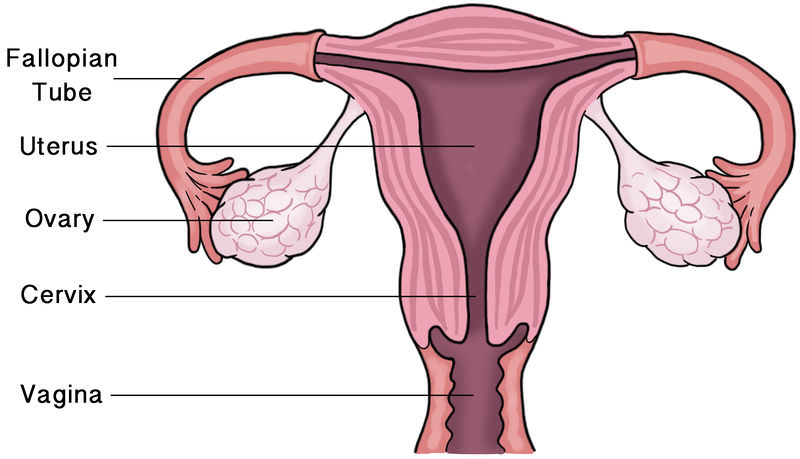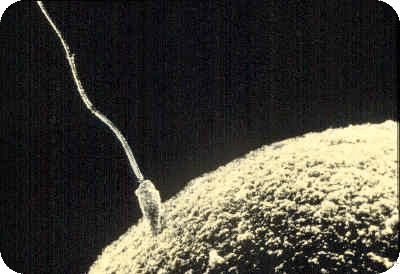11.71 化肥化
章节大纲
-
Where do meet the egg ?
::鸡蛋在哪里碰头?You might guess that sperm meet the egg in the uterus , the organ where the baby develops. But that is incorrect. The sperm meet the egg in the fallopian tubes that carry the egg from the ovary to the uterus. Then the developing embryo travels to the uterus.
::你可能会猜到精子在子宫里碰到卵子, 也就是婴儿发育的器官。但是这是错误的。精子在从卵巢到子宫的输卵管里碰到卵子。然后发育中的胚胎进入子宫。Fertilization and Implantation
::化肥和植种The sperm and egg don’t look anything like a human baby ( Figure ). After they come together, they will develop into a human being. How does a single cell become a complex organism made up of billions of cells? Keep reading to find out.
::精子和卵子看起来不像是人类的婴儿(图 ) 。 它们聚集在一起后会发展成人类。 单细胞如何变成一个由数十亿细胞组成的复杂有机体? 继续阅读以找出答案。Sexual reproduction happens when a sperm and an egg cell combine together. This is called fertilization . Sperm are released into the vagina during sexual intercourse. They “swim” through the uterus and enter a fallopian tube . This is where fertilization normally takes place.
::当精子和卵细胞结合时,即发生性生殖,这被称为授精;在性交期间,Sperm被放入阴道;它们通过子宫“游泳”进入输卵管,并进入输卵管,这是通常进行授精的地方。A sperm that is about to enter an egg is pictured below ( Figure ). If the sperm breaks through the egg’s membrane, it will immediately cause changes in the egg that keep other sperm out. This ensures that only a single sperm can penetrate an egg. It will also cause the egg to go through . Recall that , that creates the egg, begins long before an egg is released from an ovary. In fact, it begins prior to birth.
::即将进入蛋的精子将在下面(图 ) 。 如果精子通过卵子的膜破裂,它会立即导致卵子的变化,让其他精子消失。 这确保只有单一精子才能渗入卵子。它也会让卵子通过。 提醒人们,产卵的卵从卵卵卵释放之前很久就开始了。 事实上,它从出生前就开始了。This sperm is ready to penetrate the membrane of this egg. Notice the difference in size of the sperm and egg. Why is the egg so much larger? The egg contributes all the cytoplasm and organelles to the zygote. The sperm only contributes one set of chromosomes. The sperm and egg each have only half the number of chromosomes as other cells in the body. These cells are haploid , with a single set of chromosomes. This is because when they combine together, they form a cell with the full number of chromosomes. The cell they form is called a zygote . The zygote is diploid , with two sets of chromosomes, one from each parent. A human zygote has two sets of 23 chromosomes, for a total of 46 chromosomes (23 pairs). The zygote slowly travels down the fallopian tube to the uterus. As it travels, it divides by mitosis many times. It forms a hollow ball of cells.
::精子和蛋各只有一半的染色体, 和身体中的其他细胞一样。 这些细胞是杂交的, 有一套单一的染色体。 这是因为当它们合在一起时, 它们组成一个细胞, 配有全部的染色体。 它们构成的细胞被称为zygote。 zygote是diploid, 配有两套染色体, 每套来自父母一方。 人类zygote有两套23个染色体, 共46个染色体( 23对) 。 zygote 缓慢地从输入输卵管到子宫。 当它们穿梭时, 它会分化许多次。 它会形成一个空洞的细胞球。After the ball of cells reaches the uterus, it fixes itself to the side of the uterus. This is called implantation . It usually happens about a week after fertilization. Now the implanted ball of cells is ready to continue its development into a baby.
::细胞球到达子宫后, 它把自己固定在子宫的侧面。 这叫做植入。 通常在受精后一周左右发生。 现在, 植入的细胞球可以继续发育成婴儿。Summary
::摘要-
Fertilization occurs when an egg and sperm come together to form a zygote.
::当一个蛋和精子聚集在一起形成一个zygote时,就会发生化肥化。 -
Implantation occurs when the developing embryo fixes itself to the side of the uterus.
::当发育中的胚胎固定在子宫一侧时,就会发生植入。
Explore More
::探索更多-
How long after fertilization does it take the zygote to reach the uterus?
::受精后多久 zygote才能到达子宫? -
About how many cells is the embryo at the time of implantation?
::植入时胚胎有多少细胞? -
What prevents the uterine lining from being shed if an egg is fertilized?
::如果卵被施肥,有什么能阻止子宫膜脱落呢? -
How does the developing embryo receive nutrition?
::发育中的胚胎如何获得营养?
Review
::回顾-
What is fertilization?
::什么是施肥? -
Where does fertilization take place?
::在哪里施肥? -
What is a zygote? How many chromosomes does a human zygote normally have?
::什么是zygote?人类zygote通常有多少染色体? -
If the egg is fertilized, what immediately happens next?
::如果卵被施肥,接下来会发生什么? -
Where does implantation take place?
::植入在哪里进行?
-
Fertilization occurs when an egg and sperm come together to form a zygote.

